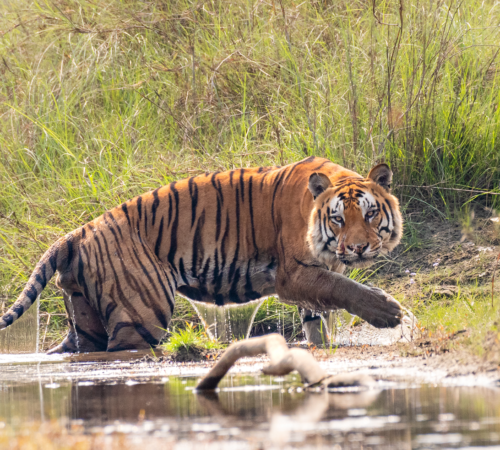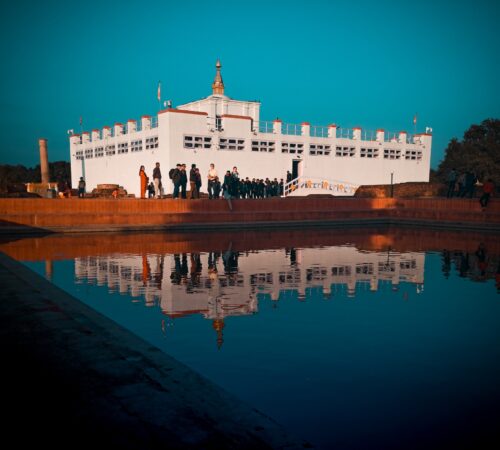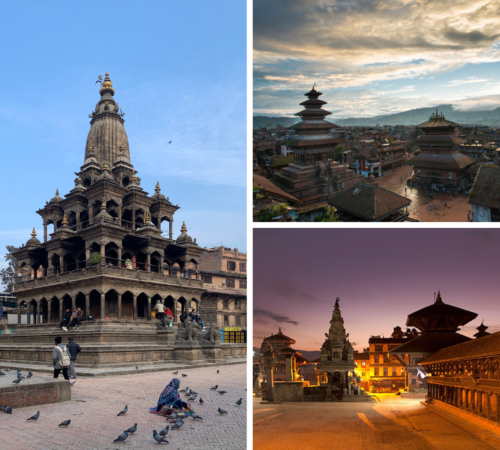Trip Facts
-
Duration
36 Days
-
Difficulty Level
Challenging
-
Trip Area
Dharchula
-
Maximum Altitude
7132m/23,398.95ft - Api Himal Summit
-
Best Season
Sep - Nov, Feb - May
-
Meals
Full board (please check the details)
-
Accommodation
Hotel, Lodge, Tent
-
Transportation
Air, Land
Highlights
Remote Location: Api Himal is located in the far-western region of Nepal, making it one of the more isolated and less commercialized peaks. This remoteness adds to the adventure and provides a unique experience.
High Altitude Climbing: Climbing Api Himal is a physically demanding and technically challenging endeavor due to the high altitude and unpredictable mountain conditions. Climbers need to acclimatize carefully and be well-equipped.
Stunning Scenery: The journey offers breathtaking views of the Himalayan landscape, including pristine glaciers, rugged terrain, and panoramic vistas. It’s an opportunity to immerse oneself in the natural beauty of the region.
Adventure and Exploration: Expeditions to Api Himal are often chosen by adventurers and mountaineers seeking a more unexplored and authentic experience in the Himalayas. It provides a sense of discovery and exploration.
Cultural Experience: The expedition also offers opportunities to interact with local communities and experience the unique culture of the far-western region of Nepal.
Commitment to Safety: Safety is paramount in high-altitude mountaineering. Experienced guides and proper equipment are crucial to managing the risks associated with such expeditions.
Trip Overview
Conquering Heights: The API Himal Expedition
In the heart of the majestic Himalayas lies an adventure that beckons the brave and the bold—the API Himal (7,132 meters 23,390 feet) Expedition. This thrilling journey isn't just about scaling towering peaks; it's a testament to human endurance, teamwork, and the indomitable spirit of exploration. Led by seasoned mountaineers and supported by cutting-edge technology, this expedition isn't just a climb—it's a metaphor for overcoming obstacles and reaching new heights, both literal and metaphorical.
At the core of the API Himal Expedition is a deep reverence for the Himalayan landscape and its significance in global mountaineering lore. The expedition isn't merely about summiting peaks but also about understanding the fragile ecosystem of the region and fostering sustainable practices. As climbers navigate through treacherous terrain and unpredictable weather, they are reminded of the need to tread lightly and leave minimal impact on these pristine mountains. Through partnerships with local communities and environmental organizations, the expedition strives to promote conservation efforts and ensure that future generations can continue to marvel at the Himalayas' breathtaking beauty.
Yet, amidst the challenges and the risks, the API Himal Expedition is also a celebration of the human spirit's resilience and the bonds forged in adversity. Each step taken towards the summit is a testament to the unwavering determination and camaraderie of the climbers, who support each other through every hardship and triumph. As they stand atop the world, gazing at the vast expanse of peaks shrouded in mist, they are reminded not only of their own strength but also of the collective strength of humanity. The API Himal Expedition is more than just a mountaineering feat; it's a reminder of our capacity to dream, to conquer, and to push beyond the limits of what we once thought possible.
Peak Profile of Api Himal
Latitude: 30º 00' 19
Longitude: 80º 55' 54
1st ascent on May 10, 1960 by
Katsutoshi Hirabayashi (Japan )
Gyaltsen Norbu Sherpa (Nepal )
Upon your arrival at Tribhuvan International Airport, a representative from 8848 Nepal will be there to greet you. You will be transferred to your hotel located in the heart of Kathmandu. Our staff will assist you through the check-in process. You can choose to rest at the hotel, sight-seeing around or visit the office for more information about the expedition. In the evening, please join us for a welcome dinner organized by 8848 Nepal.
- Hotel
- 1345
Cost Includes
- All land transportation and domestic flights as required for the trip itinerary
- Pick-ups and Drop-offs in a private vehicle at the airport (Arrival & Departure)
- Hotel Accommodations (Bed & Breakfast) in the city
- 3-course meal (Breakfast, Lunch, & Dinner) during the entire trek
- Accommodations in teahouses/guesthouses/lodges and tented camps as per the nature of the trek
- Necessary climb and trek permits, national parks, and restricted areas entrance fees
- First-aid Medical Kits
- Experienced and government license holder English-speaking trekking guides
- Porters (2 trekkers: 1 porter), supporting crews, cooks, & asst. cooks (depending on the nature of the trek)
- Allowances for crew staff including insurance on medical grounds
- All government taxes, official charges
Cost Excludes
- International Airfare
- Nepal Entry Visa Fees
- Personal Expenses
- Additional charges in the tea/guesthouses (Wi-Fi, electricity charge, hot shower, laundry, boiled water)
- Meals (Lunch & Dinner) in Kathmandu
- Extra night’s stay accommodation and meals in Kathmandu
- All kinds of Alcoholic & Non-alcoholic Beverages, Mineral Water
- Personal Trekking Gears
- Emergency Rescue cost & Travel Insurance cost
- Tips to the supporting crew members (guides, porters, drivers) after the trip completion
- Unforeseen events
Guidelines
Nearest Help Center
Police Post: Khalanga, Darchula 66.6KM
Army Post: Khalanga, Darchula 66.6KM
Health Center: Lahuti 54.1KM Ghusa 21.8KM
Nearest Settlement: Dumbling 28.3KM Lawthi 14.3KM
Accommodation
Accommodations in the during the expedition is mostly tented camps. In the city, the hotel is the accommodation. For the use of Wi-Fi, charging electronic devices, hot water buckets, laundry, and boiled water, trekkers must pay an additional charge.
Meals
In the city, only breakfast is provided. During the entire expedition, a full 3-course meal (breakfast, lunch, and dinner) is provided at the campsite. The meals are basic but organic and healthy suitable for the health of the trekkers. The prime dish is Nepali Dal-Bhat served with vegetable curry and pickles. Besides Dal-Bhat, noodles, soups, Sherpa stew, hot drinks, roti, and fresh curries are served.
Drinking water
Drinking water keeps the body hydrated which is essential during the trek. In the Himalayas, water is pure and fresh. One can directly drink water from the natural stream from the Himalayas or one can fill up the boiled water at villages enroute, paying an additional charge. However, water-purifying solution kits are essential. Remember to carry a water bottle to minimize the use of plastic bottles.
Communication
The internet connectivity is stable and easily accessible in the lower regions of expedition. But, in the higher regions both mobile network and internet connectivity is unstable, and sometimes no connection at all. One can also purchase a local Sim to use the phone and mobile data internet in the lower regions.
Required Permits
Royalty Fees
Nepalese (NRs):
Spring 6000, Autumn 3000,Winter/Summer 1500
Foreigners (USD):
Spring 500, Autumn 250, Winter/Summer 125
Travel Insurance
Travel Insurance is required while trekking and climbing in Nepal. Travel Insurance makes your journey stress-free. It acts as a safety tool that prevents unforeseen and unwanted events during the travel journey. One must get travel insurance from a trusted insurance company. It must cover all emergencies, flight cancelations, loss/theft of luggage, altitude over 3000m, evacuations, and medical difficulties.
Safety and our guides
The client’s safety is our topmost priority. So, when it comes to safety one can 100% trust us. Our guides are certified and have years of experience in this field. They are aware of the technical difficulties, altitude sickness, and health of the trekkers in the Himalayas. Thus, they are fully prepared and always carry necessary medical kits, safety tools, and are experts in safety performances. From the beginning to the end of the trek, the client’s safety is taken into consideration and kept as a high priority. Therefore, all the program itineraries are carefully planned and scheduled with proper acclimatization and rest days to prevent altitude sickness and adapt to the higher altitude. We are available 24/7 at your service. Hence, feel free to ask queries and share your thoughts.
Best time for Api Himal Expedition
All seasons have their beauty. But, when it comes to climbing the Api Himal, Spring and Autumn seasons are termed best. These two seasons are the best time to explore as the weather is clear, the days are bright, and trekking trails are easy to walk. Spring and Autumn season is followed by the Summer season to trek in the Api Himal region. Winter and Rainy seasons are riskier due to muddy, slippery, and snowy trails. The weather is also uncertain and the chances of the temperature fluctuating are high making it cold for the trekkers. It is advisable to properly plan before trekking in the rainy and winter seasons in the region.
Api Himal Expedition Difficulty
The Api Himal Expedition is a challenging and demanding adventure, suitable for experienced climbers with a high level of physical fitness and technical skills. This expedition involves several factors that contribute to its difficulty:
- Altitude and Acclimatization: Reaching heights of over 7,000 meters (22,966 feet), the expedition requires careful acclimatization to prevent altitude sickness. The thinning air at such elevations poses significant challenges, making it essential to have prior experience in high-altitude climbing.
- Technical Climbing: The route to the summit includes technical sections that require proficiency in using ropes, crampons, ice axes, and other climbing gear. Climbers must be adept at negotiating steep ice and snow slopes, crevasses, and potentially unstable rock sections.
- Weather Conditions: The weather in the Himalayas is notoriously unpredictable and can change rapidly. Climbers must be prepared to face extreme cold, high winds, and sudden storms, which can add to the complexity and danger of the ascent.
- Physical Endurance: The expedition demands high levels of stamina and strength. Climbers will need to endure long days of trekking and climbing, often in harsh conditions, while carrying heavy loads of gear and supplies.
- Remote and Rugged Terrain: The approach to Api Himal involves trekking through remote and rugged terrain, far from medical facilities or rescue services. This isolation requires climbers to be self-sufficient and prepared for emergencies.
- Logistical Challenges: Organizing an expedition to Api Himal involves complex logistics, including the transport of equipment and supplies, setting up multiple camps, and coordinating with support staff such as porters and Sherpas.
Given these factors, the Api Himal Expedition is best suited for seasoned mountaineers who have previous experience with high-altitude expeditions and are well-prepared for the physical and technical demands of the climb. Proper preparation, training, and a reliable support team are crucial for a successful and safe ascent.
Altitude Sickness and Acclimatization
Altitude sickness is common at an altitude above 3000m. Here in Nepal, during trekking, altitude sickness chances are high. The high elevation, the weather, and the temperature play a key role. Thus, to prevent altitude sickness, acclimatization is quintessential. Thus, the acclimatization rest days are carefully scheduled to adapt to the surroundings. All age groups and even healthy people can suffer from altitude sickness. But, no need to panic as its symptoms and precautionary advice is given below:
Altitude Sickness Symptoms
The symptoms of altitude sickness are primary at the initial stage and get extreme if primary symptoms are not taken into consideration.
Primary symptoms: Headache, vomiting, breathlessness, loss of appetite & sleep, tiredness, vertigo
Extreme symptoms: primary symptoms along with delusions & unconsciousness
Precautionary Advice
- Inform the guide immediately
- Stretch the body and do warm ups before the start of the trekking journey
- Keep yourself hydrated by drinking water at regular intervals
- Urinate frequently throughout the journey
- Keep it slow and steady
- Take proper rest and sleep
- Avoid taking salty and unhygienic foods
- Avoid consuming alcohol, and smoking
- If it feels uneasy or difficult, immediately descend
- Consult a guide to taking a medicine
Porter Luggage limitation
One porter is assigned to carry the luggage of two trekkers. The luggage limitation is a maximum of 15 kg per trekker.
However, the climbers need not carry any luggage during the climb to the summit.
Equipment checklist
Essential Documents: Passport, Travel Permits, Visa Photocopy, Passport size photos
Food: Light snacks, Energy bars, and drink mix
Shoes: Camp shoes, Pair of hiking boots, Rubber sandals
Clothes: Windcheater jacket, Thermals, Insulating Down Jacket, Fleece, Long sleeve shirts, Gloves, Towels, Inner garments, Trekking pants, Trousers, Shorts, Socks, Raincoat, Balaclava, Bandana, Gaiters
Accessories: Sunglasses, Hats/Caps, Sunscreen, Lip Balm, Water bottles, Pocket Knife, Solar chargers, Batteries, Head Lamps, Torch, Umbrella, Sewing kit, Water Purifying solution kits, reusable bags to deposit waste, and separate clean/dirty clothes
Equipment & Gears: Warm Sleeping bags, Map, Trekking poles, Duffel bag.
Medicine: First-Aid Kit, Altitude sickness medicines, Insect repellents, Blister kits, Approved medicines
Rainy season: Waterproof clothes, boots, Raincoat, Anti-leech socks
Winter Season: Light woolen clothing items
Personal Hygiene Kit: Hand sanitizer, wet wipes, napkins, sachet shampoo, moisturizer, hand wash/soaps, toothbrush, toothpaste, comb/brush, razor, and for ladies (menstrual kits)
Note: One can customize the above. Only bring necessary items from the provided list from your home or one can rent or purchase here in Nepal.













